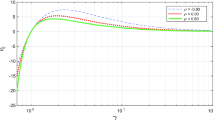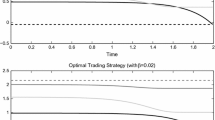Abstract
We present a unified approach for partial information optimal investment and consumption problems in a non-Markovian Itô process market. The stochastic local mean rate of return and the Wiener process cannot be observed by the agent, whereas the path-dependent volatility, the path-dependent interest rate and the asset prices can be observed. The main assumption is that the asset price volatility is a nonanticipative functional of the asset price trajectory. The utility functions are general and satisfy standard conditions. First, we show that the corresponding full information market is complete and in this setting we solve the problem using standard methods. Second, we transform the original partial information problem into a corresponding full information problem using filtering theory, and show that it follows that the market is observationally complete in the sense that any contingent claim adapted to the observable filtration is replicable. Using the solutions of the full information problem we then easily derive solutions to the original partial information problem.
Similar content being viewed by others
Notes
The term complete with respect to \(\underline{\mathcal {F}}^S\) is also used, see e.g. Hahn et al. (2007).
The proof of the first part of the proposition is found in Kallianpur (1980, Theorem 5.1.2) and in Liptser and Shiryayev (2001, Theorem 4.6). The proof of the second part is easiest found in Kallianpur (1980, Section 5.2) but the reasoning can also be found in the proof of Theorem 5.16 and Theorem 5.17 in Liptser and Shiryayev (2001). Regarding Definition 2.2: several different Lipschitz and growth conditions guaranteeing the existence of a unique strong solution are used in the literature (see e.g. Kallianpur 1980 or Liptser and Shiryayev 2001, or, for less general stochastic differential equations, Karatzas and Shreve 1991 or Øksendal 2003). Similar remarks apply to Definition 2.1.
Here \('\) denotes transposition. However, \('\) will sometimes denote the derivative. What is meant should be clear from the context.
Note that we in this proposition restrict the process \(\gamma \) to be \(\underline{{\mathcal {F}}}^\xi \)-progressively measurable, rather than just \(\underline{{\mathcal {F}}}\)-progressively measurable.
See e.g. Fujisaki et al. (1972), Kallianpur (1980, Chapter 8) or Liptser and Shiryayev (2001, Chapter 8) for similar results and definitions, and also justifications of the definitions. Recall (for a given filtration) that a progressively measurable process is adapted and measurable, that a process which is measurable and adapted has a progressively measurable modification, and that an adapted process with every sample path right-continuous or left-continuous is progressively measurable, see Karatzas and Shreve (1991, Chapter 1).
Karatzas and Shreve (1998) also have a slightly different setup in other respects. For example, they analyze the portfolio process \(\pi _t\) rather than our portfolio weights process \(u_t\), see Definition 3.2. The filtration of their market is moreover generated by the Wiener process driving the asset prices. The proofs of Karatzas and Shreve (1998) can easily be modified to our setup and are not included.
\(\mathbf{1}\) is an n-dimensional vector with each element equal to 1.
Thus \((1-u_t\mathbf{1})\) represents the weight in the bank account \(B_t\).
For further details see e.g. Karatzas and Shreve (1998).
Corollary 2.11 is a more formal version of this reasoning.
\(\int _0^T||\sigma _t^{-1}(S)\hat{\alpha }_t||^2{ dt} < \infty \) a.s. can be shown to follow from Assumption 5.1.
References
Bäuerle N, Rieder U (2005) Portfolio optimization with unobservable Markov-modulated drift process. J Appl Probab 42(2):362–378
Bäuerle N, Rieder U (2007) Portfolio optimization with jumps and unobservable intensity process. Math Finance 17(2):205–224
Björk T, Davis MH, Landén C (2010) Optimal investment under partial information. Math Methods Oper Res 71(2):371–399
Callegaro G, Di Masi G, Runggaldier W (2006) Portfolio optimization in discontinuous markets under incomplete information. Asia Pac Financ Mark 13(4):373–394
Dothan MU, Feldman D (1986) Equilibrium interest rates and multiperiod bonds in a partially observable economy. J Finance 41(2):369–382
Elliott RJ, Rishel RW (1994) Estimating the implicit interest rate of a risky asset. Stoch Process Appl 49(2):199–206
Frey R, Gabih A, Wunderlich R (2012) Portfolio optimization under partial information with expert opinions. Int J Theor Appl Finance 15(1):1–18
Fujisaki M, Kallianpur G, Kunita H (1972) Stochastic differential equations for the non linear filtering problem. Osaka J Math 9(1):19–40
Hahn M, Putschögl W, Sass J (2007) Portfolio optimization with non-constant volatility and partial information. Braz J Probab Stat 21(1):27–61
Honda T (2003) Optimal portfolio choice for unobservable and regime-switching mean returns. J Econ Dyn Control 28(1):45–78
Kallianpur G (1980) Stochastic filtering theory. Springer, Berlin
Karatzas I, Shreve SE (1991) Brownian motion and stochastic calculus. Springer, Berlin
Karatzas I, Shreve SE (1998) Methods of mathematical finance. Springer, Berlin
Karatzas I, Lehoczky JP, Shreve SE (1987) Optimal portfolio and consumption decisions for a “small investor” on a finite horizon. SIAM J Control Optim 25(6):1557–1586
Korn R, Seifried FT (2013) A concise characterization of optimal consumption with logarithmic preferences. Int J Theor Appl Finance 16(06):1–7
Lakner P (1995) Utility maximization with partial information. Stoch Process Appl 56(2):247–273
Lakner P (1998) Optimal trading strategy for an investor: the case of partial information. Stoch Process Appl 76(1):77–97
Liptser RS, Shiryayev AN (2001) Statistics of random processes: I. General theory. Springer, Berlin
Merton RC (1969) Lifetime portfolio selection under uncertainty: the continuous-time case. Rev Econ Stat 51(3):247–257
Merton RC (1971) Optimum consumption and portfolio rules in a continuous-time model. J Econ Theory 3(4):373–413
Øksendal B (2003) Stochastic differential equations. Springer, Berlin
Pliska SR (1986) A stochastic calculus model of continuous trading: optimal portfolios. Math Oper Res 11(2):371–382
Putschögl W, Sass J (2008) Optimal consumption and investment under partial information. Decis Econ Finan 31(2):137–170
Rogers L, Williams D (1987) Diffusions, Markov processes and Martingales, vol 2. Wiley, London
Sass J (2007) Utility maximization with convex constraints and partial information. Acta Appl Math 97:221–238
Sass J, Haussmann U (2004) Optimizing the terminal wealth under partial information: the drift process as a continuous time Markov chain. Finance Stochast 8(4):553–577
Sass J, Wunderlich R (2010) Optimal portfolio policies under bounded expected loss and partial information. Math Methods Oper Res 72(1):25–61
Author information
Authors and Affiliations
Corresponding author
Additional information
Financial support from the Tom Hedelius and Jan Wallander Foundation and The Fund Carl Silfvén is gratefully acknowledged. The author is also grateful to Professor Tomas Björk for helpful comments on this paper.
Rights and permissions
About this article
Cite this article
Lindensjö, K. Optimal investment and consumption under partial information. Math Meth Oper Res 83, 87–107 (2016). https://doi.org/10.1007/s00186-015-0521-1
Received:
Accepted:
Published:
Issue Date:
DOI: https://doi.org/10.1007/s00186-015-0521-1




